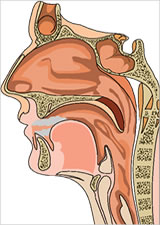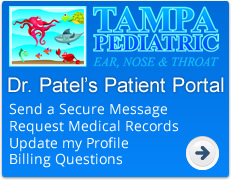Nasal Cancer
 |
Your paranasal sinuses are small hollow spaces around the nose. They are lined with cells that make mucus, which keeps your nose from drying out. The nasal cavity is the passageway just behind your nose through which air passes on the way to your throat as you breathe.
Cancer of the nasal cavity and paranasal sinuses is rare. Men are more likely than women to get it, and most patients are older than 45. There may be no symptoms at first, and later symptoms can be like those of infections. This means the cancer may not be found until it is advanced, making it harder to treat. Treatment options include surgery, radiation and chemotherapy. |
Paranasal sinus and nasal cavity cancer is a disease in which malignant (cancer) cells form in the tissues of the paranasal sinuses and nasal cavity.
Paranasal sinuses
"Paranasal" means near the nose. The paranasal sinuses are hollow, air-filled spaces in the bones around the nose. The sinuses are lined with cells that make mucus, which keeps the inside of the nose from drying out during breathing.
There are several paranasal sinuses named after the bones that surround them:
- The frontal sinuses are in the lower forehead above the nose.
- The maxillary sinuses are in the cheekbones on either side of the nose.
- The ethmoid sinuses are beside the upper nose, between the eyes.
- The sphenoid sinuses are behind the nose, in the center of the skull.
Nasal cavity
 The nose opens into the nasal cavity, which is divided into two nasal passages. Air moves through these passages during breathing. The nasal cavity lies above the bone that forms the roof of the mouth and curves down at the back to join the throat. The area just inside the nostrils is called the nasal vestibule. A small area of special cells in the roof of each nasal passage sends signals to the brain to give the sense of smell. The nose opens into the nasal cavity, which is divided into two nasal passages. Air moves through these passages during breathing. The nasal cavity lies above the bone that forms the roof of the mouth and curves down at the back to join the throat. The area just inside the nostrils is called the nasal vestibule. A small area of special cells in the roof of each nasal passage sends signals to the brain to give the sense of smell.
Together the paranasal sinuses and the nasal cavity filter and warm the air, and make it moist before it goes into the lungs. The movement of air through the sinuses and other parts of the respiratory system help make sounds for talking.
Different types of cells in the paranasal sinus and nasal cavity may become malignant.
The most common type of paranasal sinus and nasal cavity cancer is squamous cell carcinoma. This type of cancer forms in the squamous cells (thin, flat cells) lining the inside of the paranasal sinuses and the nasal cavity.
Other types of paranasal sinus and nasal cavity cancer include the following:
- Melanoma: Cancer that starts in cells called melanocytes, the cells that give skin its natural color.
- Sarcoma: Cancer that starts in muscle or connective tissue.
- Inverting papilloma: Benign tumors that form inside the nose. A small number of these change into cancer.
- Midline granulomas: Cancer of tissues in the middle part of the face.
Being exposed to certain chemicals or dust in the workplace can increase the risk of developing paranasal sinus and nasal cavity cancer.
Anything that increases your chance of getting a disease is called a risk factor. Having a risk factor does not mean that you will get cancer; not having risk factors doesn’t mean that you will not get cancer. People who think they may be at risk should discuss this with their doctor. Risk factors for paranasal sinus and nasal cavity cancer include the following:
- Being exposed to certain workplace chemicals or dust, such as those found in the following jobs:
- Furniture-making.
- Sawmill work.
- Woodworking (carpentry).
- Shoemaking.
- Metal-plating.
- Flour mill or bakery work.
- Being male and older than 40 years.
- Smoking.
Possible signs of paranasal sinus and nasal cavity cancer include sinus problems and nosebleeds.
These and other symptoms may be caused by paranasal sinus and nasal cavity cancer. Other conditions may cause the same symptoms. There may be no symptoms in the early stages. Symptoms may appear as the tumor grows. A doctor should be consulted if any of the following problems occur:
 |
- Blocked sinuses that do not clear, or sinus pressure.
- Headaches or pain in the sinus areas.
- A runny nose.
- Nosebleeds.
- A lump or sore inside the nose that does not heal.
- A lump on the face or roof of the mouth.
- Numbness or tingling in the face.
- Swelling or other trouble with the eyes, such as double vision or the eyes pointing in different directions.
- Pain in the upper teeth, loose teeth, or dentures that no longer fit well.
- Pain or pressure in the ear.
|
Tests that examine the sinuses and nasal cavity are used to detect (find) and diagnose paranasal sinus and nasal cavity cancer.
The following tests and procedures may be used:
- Physical exam and history: An exam of the body to check general signs of health, including checking for signs of disease, such as lumps or anything else that seems unusual. A history of the patient’s health habits and past illnesses and treatments will also be taken.
- Physical exam of the nose, face, and neck: An exam in which the doctor looks into the nose with a small, long-handled mirror to check for abnormal areas and checks the face and neck for lumps or swollen lymph nodes.
- X-rays of the head, neck, and chest: An x-ray is a type of energy beam that can go through the body and onto film, making a picture of areas inside the body.
- Nasoscopy: A procedure to look inside the nose for abnormal areas. A nasoscope is inserted into the nose. A nasoscope is a thin, tube-like instrument with a light and a lens for viewing. It may also have a tool to remove tissue samples, which are checked under a microscope for signs of cancer.
- Biopsy: The removal of cells or tissues so they can be viewed under a microscope by a pathologist to check for signs of cancer.
Certain factors affect prognosis (chance of recovery) and treatment options.
The prognosis (chance of recovery) and treatment options depend on the following:
- Where the tumor is in the paranasal sinus or nasal cavity and whether it has spread.
- The size of the tumor.
- The type of cancer.
- The patient's age and general health.
- Whether the cancer has just been diagnosed or has recurred (come back).
Paranasal sinus and nasal cavity cancers often have spread by the time they are diagnosed and are hard to cure. After treatment, a lifetime of frequent and careful follow-up is important because there is an increased risk of developing a second kind of cancer in the head or neck.
After paranasal sinus and nasal cavity cancer has been diagnosed, tests are done to find out if cancer cells have spread within the paranasal sinuses and nasal cavity or to other parts of the body.
The process used to find out if cancer has spread within the paranasal sinuses and nasal cavity or to other parts of the body is called staging. The information gathered from the staging process determines the stage of the disease. It is important to know the stage in order to plan treatment. The following tests and procedures may be used in the staging process:
- X-rays of the head, neck, and chest: An x-ray is a type of energy beam that can go through the body and onto film, making a picture of areas inside the body.
- Endoscopy: A procedure to look at organs and tissues inside the body to check for abnormal areas. An endoscope is inserted through an opening in the body, such as the nose or mouth. An endoscope is a thin, tube-like instrument with a light and a lens for viewing. It may also have a tool to remove tissue or lymph node samples, which are checked under a microscope for signs of disease.
- CT scan (CAT scan): A procedure that makes a series of detailed pictures of areas inside the body, taken from different angles. The pictures are made by a computer linked to an x-ray machine. A dye may be injected into a vein or swallowed to help the organs or tissues show up more clearly. This procedure is also called computed tomography, computerized tomography, or computerized axial tomography.
- MRI (magnetic resonance imaging) with gadolinium: A procedure that uses a magnet, radio waves, and a computer to make a series of detailed pictures of areas inside the body. Sometimes a substance called gadolinium is injected into a vein. The gadolinium collects around the cancer cells so they show up brighter in the picture. This procedure is also called nuclear magnetic resonance imaging (NMRI).
- Bone scan: A procedure to check if there are rapidly dividing cells, such as cancer cells, in the bone. A very small amount of radioactive material is injected into a vein and travels through the bloodstream. The radioactive material collects in the bones and is detected by a scanner.
There are three ways that cancer spreads in the body.
The three ways that cancer spreads in the body are:
- Through tissue. Cancer invades the surrounding normal tissue.
- Through the lymph system. Cancer invades the lymph system and travels through the lymph vessels to other places in the body.
- Through the blood. Cancer invades the veins and capillaries and travels through the blood to other places in the body.
When cancer cells break away from the primary (original) tumor and travel through the lymph or blood to other places in the body, another (secondary) tumor may form. This process is called metastasis. The secondary (metastatic) tumor is the same type of cancer as the primary tumor. For example, if breast cancer spreads to the bones, the cancer cells in the bones are actually breast cancer cells. The disease is metastatic breast cancer, not bone cancer.
There is no standard staging system for cancer of the sphenoid and frontal sinuses.

Pea, peanut, walnut, and lime show tumor sizes.
>> Back to Sinus & Nose Conditions
|



 The nose opens into the nasal cavity, which is divided into two nasal passages. Air moves through these passages during breathing. The nasal cavity lies above the bone that forms the roof of the mouth and curves down at the back to join the throat. The area just inside the nostrils is called the nasal vestibule. A small area of special cells in the roof of each nasal passage sends signals to the brain to give the sense of smell.
The nose opens into the nasal cavity, which is divided into two nasal passages. Air moves through these passages during breathing. The nasal cavity lies above the bone that forms the roof of the mouth and curves down at the back to join the throat. The area just inside the nostrils is called the nasal vestibule. A small area of special cells in the roof of each nasal passage sends signals to the brain to give the sense of smell.
